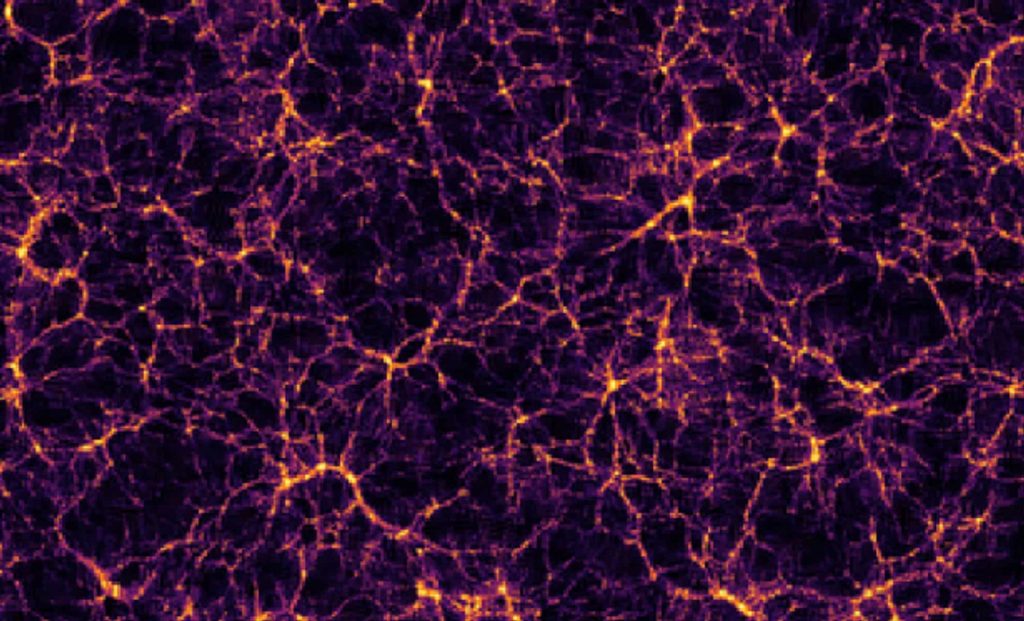Revolutionary 3D Galaxy Maps Uncover Hidden Dark Matter Structures Shaping the Universe – The Daily Galaxy –Great Discoveries Channel

Scientists are using revolutionary 3D galaxy maps and advanced computational techniques to uncover the hidden structures of dark matter, the invisible substance shaping the universe. Through a method called field-level inference (FLI), researchers are reconstructing the intricate web of dark matter by analyzing galaxy positions in unprecedented detail. This breakthrough offers new insights into how dark matter interacts with visible matter and complements existing techniques like gravitational lensing, pushing the boundaries of our understanding of the cosmos.Scientists are revolutionizing our understanding of the universe’s most mysterious component: dark matter, the invisible substance that accounts for 27% of the universe’s total mass. Using cutting-edge 3D galaxy maps and an innovative approach called field-level inference (FLI), researchers are uncovering the intricate patterns of dark matter that govern the formation and evolution of galaxies. This breakthrough combines powerful computational algorithms with observational data to create the most detailed maps yet of the dark matter field.Dark matter, though invisible, has profound gravitational effects that shape the large-scale structure of the universe. Until now, most studies relied on statistical summaries of galaxy positions or indirect observations such as gravitational lensing. However, FLI takes a more direct approach. “In field-level inference, we work directly with a 3D map of galaxies,” explained Anh Quyen Nguyen, lead author of the study and a researcher at the Max Planck Institute for Astrophysics. This groundbreaking technique allows scientists to analyze the full distribution of galaxies and their corresponding dark matter fields in extraordinary detail.Traditional methods of studying dark matter have often focused on generalized patterns, such as the clustering of galaxies or the large-scale structure of the universe. While these techniques have provided valuable insights, they can miss subtle, localized variations in the dark matter field. Field-level inference offers a transformative alternative by working directly with 3D galaxy maps to reconstruct the underlying dark matter distribution.“With the help of powerful computer algorithms, FLI aims to match those predictions with the observed galaxy position at every point on the 3D lattice,” Nguyen explained. This method involves running simulations to predict how dark matter interacts with visible matter and then comparing those predictions with real-world data. By iterating this process, researchers can refine their models and produce highly accurate maps of the dark matter field.The computational demands of this approach are immense. Modeling the distribution of galaxies and dark matter across a 3D lattice requires analyzing a vast parameter space with countless variables. However, advancements in machine learning and algorithmic efficiency have made this once-impossible task achievable. “Fortunately, there are modern computer algorithms that can speed up the exploration, or sampling, of this vast parameter space,” Nguyen noted. These advancements allow researchers to process massive amounts of data and uncover the hidden structures of dark matter with unprecedented precision.One of the key advantages of using 3D galaxy maps is the ability to detect local effects of dark matter that traditional methods might overlook. In conventional analyses, such as those using n-point correlation functions, these local variations are often averaged out, obscuring finer details of the dark matter field.“By having access to the entire underlying field of dark matter associated with the observed galaxy field, we might be more sensitive to local effects,” Nguyen explained. This sensitivity enables researchers to study how dark matter interacts with visible matter on small and intermediate scales, shedding light on processes like galaxy formation and clustering.The 3D maps generated by FLI also complement other dark matter mapping techniques, such as gravitational lensing. While gravitational lensing measures the bending of light caused by massive objects, FLI reconstructs the dark matter field based on galaxy positions. Together, these methods provide a more comprehensive view of the dark matter scaffolding that shapes the universe. “That’s quite neat, given that we can’t observe dark matter directly, and is complementary to dark-matter maps constructed from gravitational lensing,” said Fabian Schmidt, a co-author of the study.The maps generated through field-level inference offer a detailed picture of how dark matter shapes the universe at every scale. From the vast cosmic web of galaxies and voids to the intricate structures surrounding individual galaxy clusters, these maps reveal the hidden scaffolding of the cosmos.Dark matter is believed to play a crucial role in galaxy formation by providing the gravitational pull needed to draw ordinary matter together. Without it, the observed distribution of stars and galaxies in the universe would not be possible. The ability to map dark matter with such precision allows scientists to test theories about its nature, such as whether it consists of exotic particles like WIMPs (Weakly Interacting Massive Particles) or if alternative explanations, like modifications to gravity, are needed.Moreover, the sensitivity of FLI to local variations in dark matter opens the door to studying phenomena that were previously out of reach. By analyzing how dark matter interacts with individual galaxies or small groups of galaxies, researchers can gain new insights into its behavior and properties.The success of field-level inference would not be possible without the tremendous advancements in computational power and algorithmic innovation. Simulating the distribution of dark matter and galaxies across a 3D lattice requires immense processing capabilities, as well as sophisticated algorithms that can efficiently explore complex parameter spaces.These computational tools allow scientists to run simulations of how dark matter evolves over billions of years and compare the results with real-world observations. This iterative process refines the models until they accurately reproduce the observed galaxy positions and distributions.By integrating these computational techniques with observational data, researchers are not only uncovering the hidden structures of dark matter but also advancing the field of astrophysics as a whole. These methods could have applications beyond dark matter research, potentially informing studies of dark energy, black holes, and the early universe.The use of 3D galaxy maps and field-level inference marks a significant step forward in our quest to understand the universe. By moving beyond traditional statistical methods, scientists are uncovering the intricate details of the dark matter field that were previously inaccessible.“By having access to the entire underlying field of dark matter associated with the observed galaxy field, we might be more sensitive to local effects,” Nguyen emphasized. These breakthroughs are not only deepening our understanding of dark matter but also transforming how we study the cosmos.As computational power continues to grow, these techniques will become even more refined, offering unprecedented insights into the dark universe. From uncovering the origins of galaxies to testing fundamental theories of physics, the possibilities are as vast as the cosmos itself. With each discovery, we move closer to unraveling the mysteries of the universe’s invisible backbone, bringing the dark universe into focus like never before.Got a reaction? Share your thoughts in the commentsEnjoyed this article? Subscribe to our free newsletter for engaging stories, exclusive content, and the latest news.Comment Save my name, email, and website in this browser for the next time I comment.
© 2024 | Daily Galaxy | All rights reserved
Source: https://dailygalaxy.com/2025/01/3d-galaxy-maps-uncover-hidden-dark-matter/






